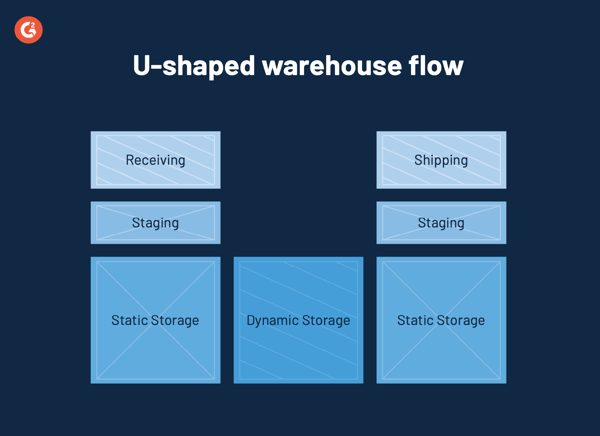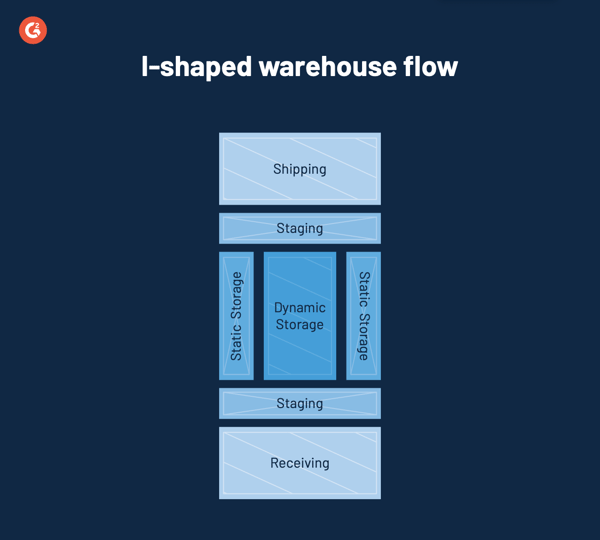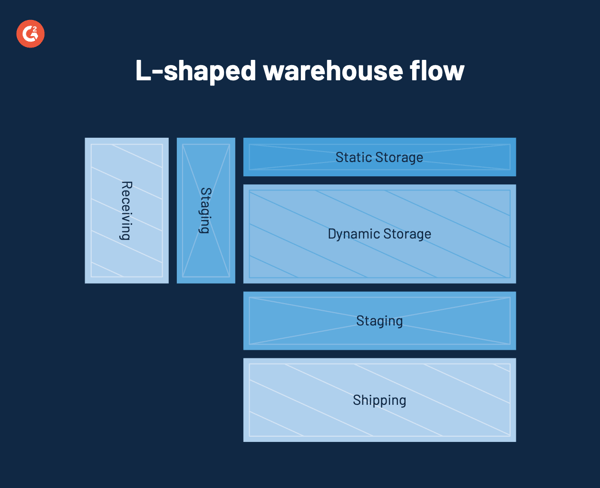Successful warehouse operations start in the right space.
Creating the warehouse space of your dreams is all about optimizing what you have, what you need, and what you want. With a warehouse layout, your organization can customize warehouse movement and increase overall inventory accessibility.
What is a warehouse layout?
A warehouse layout is the planned design of a warehouse to streamline overall operations. The right layout should help to improve the flow of production and distribution.
Overseeing an entire warehouse workflow is extremely tedious. That’s why some companies utilize warehouse management software to automate the process. Warehouse management tools help to improve overall visibility into warehouse operations and track how products move between locations.
Why warehouse design is important
A good warehouse layout should improve the flow of your facility. But there are many more things a warehouse layout can do to enhance the way you operate. These objectives contribute to the main purpose of keeping costs down and productivity up. Here are some goals an effective warehouse layout will help you reach.
Optimize warehouse space
The most significant objective of a warehouse layout is to optimize the way warehouse space is used. Using warehouse space effectively allows companies to reduce the time it takes to produce a product and get it out the door, gain visibility into what is and isn’t working in the warehouse, and organize inventory to streamline the process at every stage.
Every inch of a warehouse should be utilized to its fullest potential. Being well-versed in the warehouse area and size is critical because your chosen layout will impact how much you achieve in the space overall.
Increase productivity
Every company wants to improve productivity and speed up order fulfillment without sacrificing quality. The right warehouse layout design aims to optimize operations while reducing the chances of bottlenecks or errors.
67%
of survey respondents took their business elsewhere when they were notified that an item was out of stock after placing an order.
Source: Stitchlabs
Warehouse management teams work closely with operations management teams to ensure production runs smoothly from start to finish and orders are fulfilled effectively.
Utilize labor and budgets effectively
Depending on existing warehouse floor space, some layouts may be more expensive to create and sustain than others. Finding a suitable layout means becoming very aware of what materials are available and where staff will fall into place.
Once the right warehouse layout starts to come into effect, companies can allocate resources more efficiently. This includes using budgets for warehouse maintenance and hiring the right amount of employees to carry out the processes in an environment where they can thrive.
Keep the space clean
As simple as it sounds, keeping things tidy can help to avoid significant issues within the warehouse. The right warehouse floor plan should reduce the chances of items being misplaced or mishandled, as everything has its place within the flow of operations.
Improve overall warehouse management
When everything runs efficiently, all of your warehouse operations will be set up for success. A warehouse layout contributes to the big picture of warehouse management in creating an environment where inventory is organized, stock is replenished quickly, staff is treated fairly, and orders are fulfilled.
Components of a warehouse
There are a few major areas that need to be included in a warehouse design. These areas are used to hold inventory, organize stock, prepare items for shipping, and receive items to be arranged within the warehouse system.
Each warehouse flow has five main components it houses:
- Dynamic storage holds all inventory that doesn’t have a fixed warehouse location. Items contained here are usually ones with high demand that need to be available closer to the packing areas. Because supply and demand is ever-changing, so are the contents of dynamic storage.
- Static storage holds all inventory products that have a specific location within the warehouse. This storage area has a definitive organization method and items within it are rarely moved around. Items are usually organized on racking systems to stack and fit materials in the warehouse storage space provided.
- The staging area is used to address any incoming or outgoing packages. Before a package is shipped, staging is used to pack those materials and prepare them to be picked up from the warehouse. When a package is received, staging is used to unbox the items and determine where they should be placed within the warehouse inventory system.
- The shipping area takes completed order packages and loads them onto shipping trucks to be delivered to customers or retailers.
- The receiving area is where staff can unload incoming trucks, admit the items received, and record packages as they arrive at the warehouse.
Types of warehouse flows
Once you’ve collected the necessary information and goals, you can determine which warehouse layout meets your needs. The flow of a warehouse relies heavily on the space available and how things will move within the overall operations.
There are three main types of warehouse layout flows that companies use to organize the way their warehouse operates: U-shaped, I-shaped, and L-shaped.
There is no underdog when it comes to warehouse flows. All are helpful in their own ways, and finding the right fit comes down to which one works with what you currently have and hope to achieve.
U-shaped warehouse flow
The U-shaped warehouse flow is the most common of the three. It has been recognized as the best layout for warehouse beginners. All components are arranged in a semicircle with shipping and receiving on parallel sides and storage in the middle.

The U shape is used to keep major warehouse traffic flow separate and streamlined. Keeping the incoming and outgoing materials on parallel sides of the operation helps to avoid bottlenecks. This flow of goods is also helpful in minimizing the available space necessary. With both the entrance and the exit sharing the same side of the building, less space is needed for packages, and employees can quickly move products between receiving and shipping.
A disadvantage of the U shape flow is that production congestion can occur when shipping and receiving areas are close together and share similar domains.
I-shaped warehouse flow
The I-shaped warehouse flow is favored by large corporations with bigger warehouses. This is because larger companies typically experience higher production volume and the I shape is valuable for its clear in and out workflow.

The I-shape warehouse design has a straight flow from receiving to shipping and vice versa. This setup is said to increase optimization the most as it uses the entire length of the warehouse, keeps similar products separated in an assembly-line format, and minimizes bottlenecks by avoiding back and forth movements.
The disadvantages of the I shape are that companies need to have optimal loading and unloading space on two sides of the warehouse building. Costs may increase when purchasing docking equipment for the inbound and outbound areas and goods often need to travel the entire length of the warehouse to reach their intended destination.
L-shaped warehouse flow
The L-shaped warehouse flow is considered the least common of the flow types. Its configuration is very unusual and is generally chosen to specifically accommodate an L-shaped building.

The L shape features the shipping area on one side and the receiving on the adjacent side at a 90-degree angle. The L-shaped flow and I-shaped flow are relatively similar in their advantages.
The L shape also minimizes congestions by avoiding back and forth movement and effectively separates products with inbound and outbound docks on opposite sides. The most significant disadvantage of the L-shaped design is how much space is needed to run this flow effectively.
Warehouse layout considerations
There are many factors to examine when choosing the right layout for your warehouse. The processes below should be considered when determining space requirements and the most suitable layout for your desired warehouse.
- Storage and inventory are the most important areas to consider in a layout, as they can make or break the workflow of a warehouse. Ensuring that inventory is organized and staff is equipped to work with the current storage system affects how smoothly order fulfillment will play out. Inventory management methods can be used to ensure everything is organized in a way that makes sense for streamlining distribution productivity.
- The inbound receiving dock is used to remove products and pallets from receiving trucks. Documentation is usually prepared in advance with a detailed description of the incoming materials. Those items are then unloaded from the receiving dock, counted, and prepared for shelving.
- The picking and packing areas are used to prepare incoming customer orders. The order picking process begins when an order is received and the warehouse employees, or pickers, retrieve the necessary materials. There are different methods of picking, and these methods can be influenced by the warehouse layout.
- Zone picking is the process of picking items from employee-assigned zones.
- Batch picking is when items for identical orders are picked at once.
- Discrete picking requires the warehouse employee to pick items from a single order at a time.
- Wave picking is the process of picking items in groups during specific intervals,or waves throughout the day.
The packing process begins when the necessary order items have been picked. The order is then packed and moved to the shipping phase.
- The outbound shipping dock is where the packed materials are placed onto pallet racks, lifted using forklifts, and loaded onto trucks for delivery.
- In addition to the standard production areas, consider employee space. This area should include ample space for warehouse staff to take breaks, eat, and use the restroom separate from work areas. A layout may also need to consider offices for onsite warehouse management teams.
How to design a warehouse layout
Once you know all the pieces that need to come together in your warehouse, you can start making moves towards actually designing your ideal warehouse layout. Your warehouse layout design should include all the necessary areas that your facility requires, while utilizing every inch of usable space.
1. Create a warehouse blueprint
Before actually making any decisions regarding the warehouse setup, take time to create a visual aid you can use to play around with the available space. This includes marking where shipping and receiving docks can fit, keeping in mind how many trucks you hope to fill at a time. This blueprint will help you see your warehouse as a blank canvas.
2. Start fitting components
After creating a blueprint of the warehouse and collecting measurements, you can start planning how different warehouse components can be set up. This includes offices, employee spaces, dynamic storage, static storage, staging areas, and shipping and receiving docks. All major areas should be accounted for, including assembly lines, manufacturing materials, work benches, conveyor belts, and other equipment that require allocated space.
3. Pick the flow that fits your location
After you learn about the different warehouse flows and have a good look at your space, you may have a good idea of which design will naturally fit your needs.
If you hope to keep the shipping and receiving areas close, the U-shaped warehouse flow may fulfill that. If you prefer to keep an in-and-out workflow while minimizing space usage, you may prefer the I-shaped warehouse flow. The L-shaped warehouse flow works if you have a unique shaped warehouse.
Whether you pick a popular flow or choose to do things differently, this step is important to sort out before making any major moves in the overall layout.
4. Gather equipment
After determining which flow works best for your needs, it is time to purchase and gather all the necessary equipment to streamline warehouse movements. This includes forklifts, shelving, bins, pallet racks, rolling staircases, picking and packing stations, technology to assist in the process, and other machinery that will help the warehouse run efficiently.
5. Test your plans
When in doubt, test your proposed plan. Walk through the most favorable traffic flow before implementing and installing equipment into the warehouse layout. Make sure to consider the opinions and concerns of warehouse staff and other employees who actively participate in the workflow.
Warehouse layout challenges
Despite the benefits of designing a warehouse, there are still challenges. The right warehouse layout should help to mitigate most issues you may encounter along the way. However, preparing to address these in advance is critical.
There are four major challenges you may face as you create your warehouse design and begin implementing the chosen layout.
- A huge concern is ensuring constant safety precautions are taken in the warehouse at all times. The layout should leave ample space for safely walking around and the warehouse should have constant maintenance to determine the security of equipment.
- Planning for the future is essential when creating a layout that can adapt to changes. This may mean saving specific shelving areas to accommodate for predicted order fluctuations using demand planning.
- A relatively surprising challenge is underutilizing space. All warehouse space should be included in the design and used for a specific purpose.
- On the other hand, overutilizing space is very dangerous. Overcrowded areas can create a hectic environment where injuries and disorganization are imminent. It can also cause items to be mishandled or misplaced.
Warehouse layout best practices
Once you determine you’re ready to start designing your warehouse, there are a few things you should keep in mind. Use these best practices as checklist items when creating the best layout for your organization.
Define your unique objectives
A warehouse layout should help you improve overall workflow. Before taking advantage of this, make sure the warehouse layout you choose supports your company’s specific objectives. These objectives will help in the design planning process and outline what you hope to achieve with an efficient warehouse layout, like increasing order fulfillment or decreasing shipping and delivery times.
Defining these objectives includes determining warehouse key performance indicators (KPIs), conferring with decision-makers throughout the supply chain, and keeping open communication with those involved with daily warehouse operations.
Stay organized with labeling
When in doubt, put a label on it! The key factor to keeping your warehouse layout flowing effectively is to be as organized as possible. Labels can be used in different ways to ensure every item that enters the warehouse is placed exactly where it needs to be. Labeling is also useful for warehouse employees who need to prepare for incoming customer orders.
Train warehouse staff
Guaranteeing the happiness of those who keep your warehouse running is essential. Employees are happy when they know exactly what is expected of them and how they can succeed in their roles. When implementing a new warehouse layout, a training process must be developed so all warehouse staff understands the flow and what they need to do to ensure smooth movement throughout the floor plan.
Track inventory
Tracking inventory is crucial in determining how much product you have, how much storage capacity you’ll need, and which warehouse layout can accommodate those requirements.
There are several inventory tracking techniques you can use to optimize the way you keep count of the items in your warehouse:
- Manual tracking is when warehouse staff takes count of inventory items by simply using a pen and paper.
- Spreadsheets can be used to conduct manual tracking without the risk of human mathematical errors.
- A card system is when staff fills out order cards when they notice specific items need to be replenished.
- A barcode system can be used by sticking unique barcodes on items and scanning them as they are moved around in inventory or utilized in the production process.
- A radio-frequency identification (RFID) system is installed using tags that update item locations as they are moved throughout the warehouse using radio signals.
- Cloud-based inventory management software can be used to update inventory information constantly and pull data at any time on any device.
Perform consistent maintenance
Constant maintenance is necessary to ensure your implemented warehouse layout continues to be successful. Maintenance ensures all the current warehouse processes are effective and still supporting goals.
Maintenance responsibilities include seeing that all handling equipment is functioning appropriately, taking shipping and receiving trucks to be serviced, keeping all warehousing operations clean, reorganizing inventory and storage when applicable, and conducting quality control checks.
Leverage warehouse automation
Utilizing a warehouse management system (WMS) helps eliminate human error and keeps processes running efficiently using innovative technologies. A WMS includes software that will help organize physical and virtual warehouses, manage employee productivity, monitor inbound and outbound movements, and coordinate storage and shipping processes. Warehouse management tools allow companies to leverage automation for overseeing daily operations and ensuring data is updated and available at all times.
77%
of companies are already taking automated warehouse systems very seriously and making plans to implement.
Source: G2
Go with the flow
Picking your warehouse layout can feel like a science. It’s all about analyzing your current demands, identifying your future goals, and determining what your warehouse needs to look like to meet them. There is also no limit to what you can create in the design process. Although there are three popular layout flows, how your warehouse ends up organizing movement all comes down to your capabilities and what you are hoping to achieve.
After outlining your objectives and ensuring that all necessary spaces have been considered, you will begin to put your warehouse layout puzzle together, and you’ll be one step closer to streamlining your operations.
Feeling confident about your warehouse layout design? Check out some helpful inventory management techniques to streamline how you manage warehouse organization.
